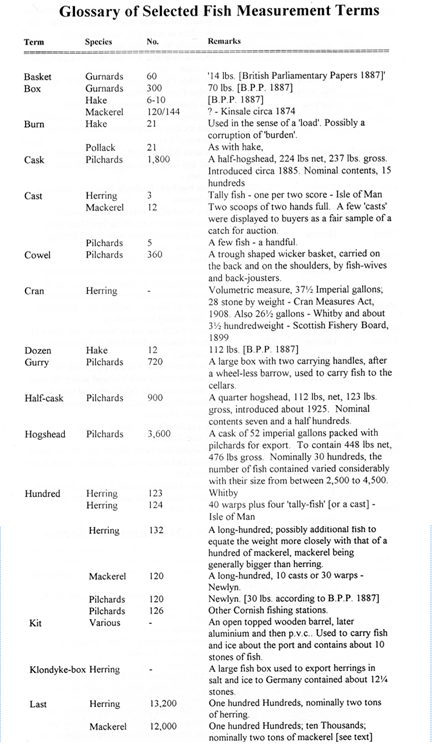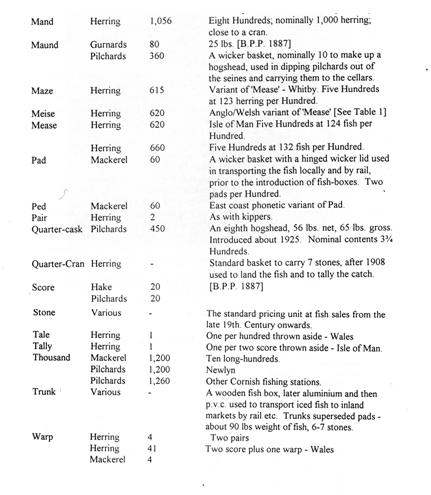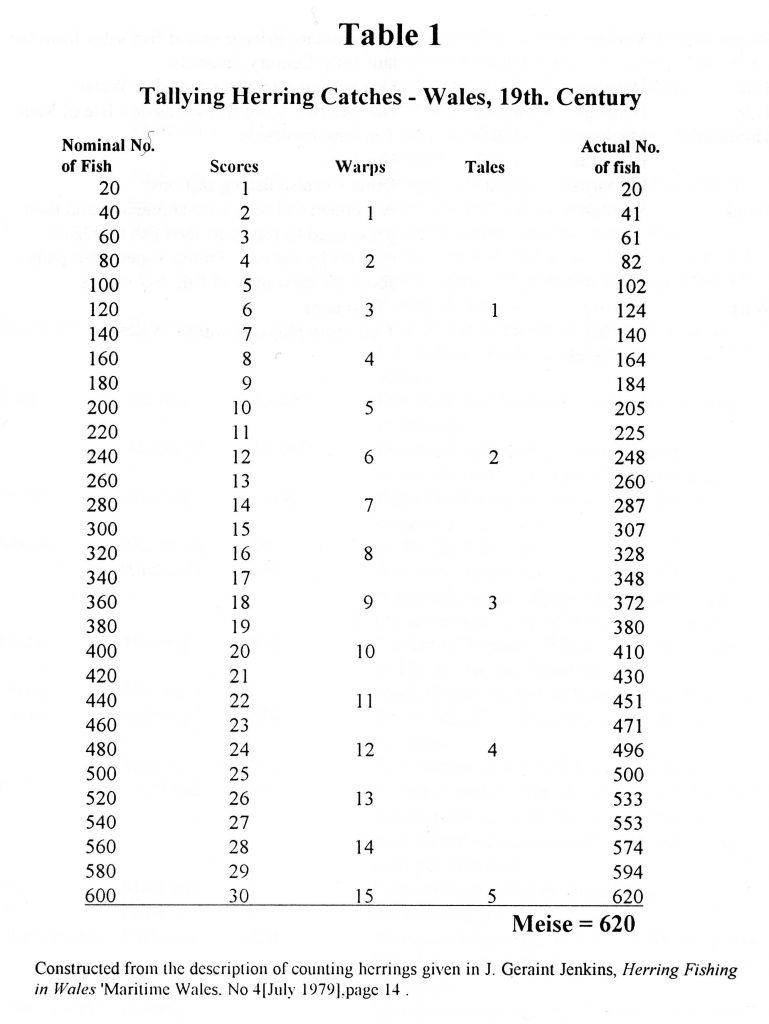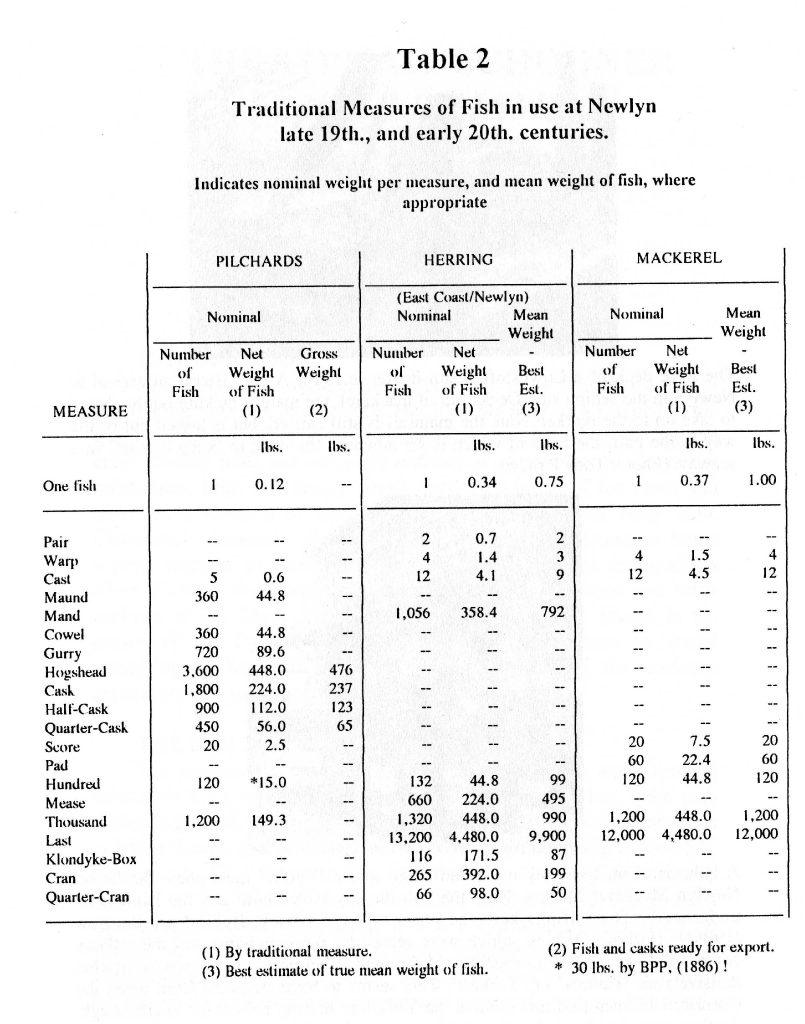PZ.486 Auld-Lang-Syne
28 August 2019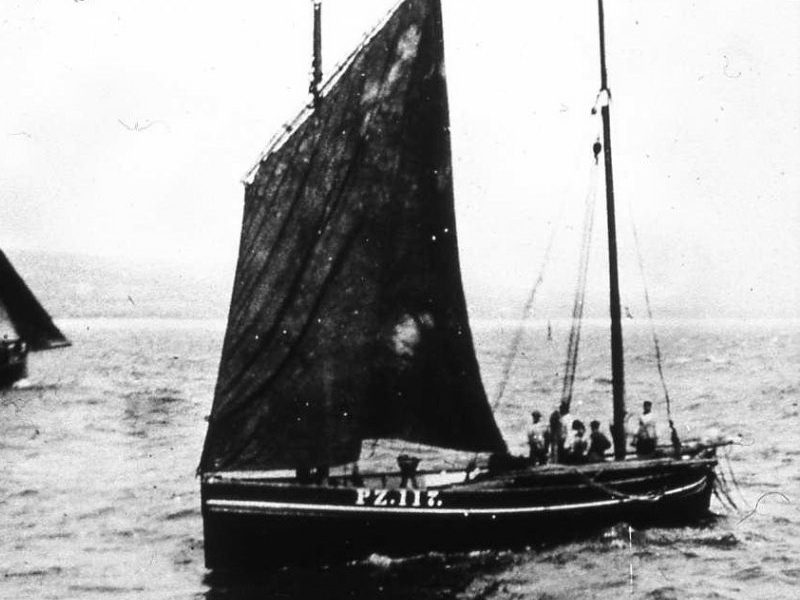
Penzance registered luggers and MFVs
30 August 2019Maunds, Pads, Hogsheads and Hundreds
I first wrote this guide for the South West Maritime History Society, back in 1995. However, the it seemed right to revise and re-publish it to accompany the series of on-line essays on Penzance registered Sea-Fishing Boats Histories.
This guide was my attempt to explain some of the many and varied traditional terms used in the measurement of fish catches. It was no simple task and I make no grand claim that this guide is fully comprehensive. However, I trust that it does give a representative view, based on my specific knowledge of terms used in Newlyn and West Cornwall, backed up by a more general acquaintance of the British Fisheries. There will be undoubtedly many terms of which I am unaware, and for the purposes of this guide I have not attempted to cover more recent terms and measures beyond the 1950s. I have certainly not allowed for ‘decimalisation,’ and while I have revised some of my previous phrasing, I have not attempted to up-date the content.
Different measures applied to different kinds of fish.
Pelagic Fish
Though individually small, these fish were caught and marketed in immense quantities. The most prolific of these fish in British waters are the pilchards, herring and mackerel, in ascending order of size. Perhaps it was just because these fish were caught in such immense quantities, and in so many different places, that that these fish have attracted so many different terms of measure. It was all a matter of custom and practice.
Pilchards, the smallest of these species were formerly [pre 1850s], the most significant Newlyn fishery. This fishery still continues in a small way, though the fish are now caught by mid-water trawl – or purse-seine. In the British context pilchards were, and are, essentially a Cornish fishery.
Herring, the next in size, were mainly caught in relatively small and irregular amounts off Newlyn, though there were periods when they were off the Cornish coast in some quantities – notably between the wars from 1920 to 1940. Essentially winter fisheries in the west, in their respective season’s herring are taken in large quantities at many fishing stations and areas all round the British Isles.
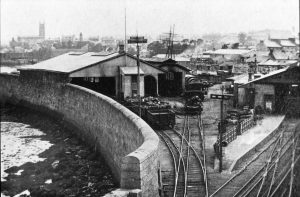
Penzance Railway Station, with mixed gauge working.
[Tony Pawlyn collection (Gibson?)]
Mackerel now became the most important branch of Newlyn’s fishery trade, with several thousand tons being sent off each season, and remained so well into the 20th Century. Though surpassed in importance in the mid 20th Century by the ‘white fish’ trade, the mackerel fishery is still a significant one at Newlyn – though now largely a sustainable fishery caught by hand-lines.
Mackerel are also taken in different sea areas all around the British Isles throughout most of the year.
Demersal Fish
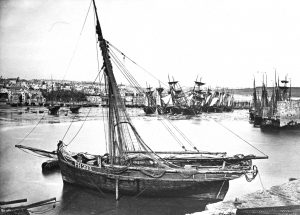
The Penzance built, Plymouth registered beam trawler Ida~PH.293, aground in the harbour mouth on the day after the Great Blizzard – March 10th 1891.
[Tony Pawlyn collection (Gibson?)]
Since the Second World War the largest part of Newlyn’s fish landings has consisted of white fish, taken primarily by motor trawlers.
Measurement Terms
Many of the terms used for measuring quantities of fish have come down to us by various tortuous routes. As such it is not surprising that there few easy or comprehensive explanations as to derivation. Contemporary written records and accounts are few and far between. Those that do exist were often set down by outside observers, who caught elements of the subject, but rarely had an understanding of the whole, and often placed individual terms out of context, or misapplied them. Some terms applied to only single species fisheries, whilst others were common across several different fisheries. Quite frequently in these latter cases the terms have acquired different meanings or values having been subjected to different evolutionary forces in the course of time. For example, while probably from the same root derivation, a pilchard Maund made to contain 300 pilchards was, by the end of the 19th Century, considerably smaller than a herring Mand which would carry 1,000 herring.
Determining the nominal amount, as against the actual content of a Herring Mand illustrates a common problem when interpreting such measures. The Herring Mand was considered by contemporaries to hold either 800 herring, or a thousand herring. In all probability a mand nominally held eight long-hundreds of herring; – i.e. 8 x 132 = 1,056 herring. So in their way both are correct given normal sized fish.
The Hundred or Long-Hundred
The hundred was probably the most common term of measurement occurring throughout Britain and was in no way restricted to the fisheries. As a very common term it has been adulterated by many subtle variations. The original long-hundred was probably ten dozens, but over the years it has acquired many differing resultant values. In West Cornwall a hundred of mackerel [the term long-hundred, being implicitly understood, was rarely specified], consisted of 120 fish, and comprised of 30 warps of four fish; as did a hundred of pilchards; whilst a hundred of herring consisted of 132 fish, 33 warps of four. However, elsewhere in Cornwall a hundred of pilchards comprised 126 fish – see below.
Part of the cause of so many different values for a long-hundred lies in the ‘local’ customary method of tallying a catch. With fish it was common practice to count by throwing the fish into piles, or containers or whatever. The bulk of the fish into one pile, with tally-fish into other piles representing different values; as with the levels on an abacus, but rarely on a decimal system.
An example of one such method of tallying comes from the Welsh herring fishery, and was described by J. Geraint Jenkins in his essay Herring Fishing in Wales [Maritime Wales, No.4, July 1979, page 14.] He actually says ‘the usual method… was to count two score of fish, throwing one fish aside as a tally. After counting five score of herrings another herring was thrown aside to denote a hundred.’ For this to work, the additional tally fish must have been for the sixth score, not the fifth, to produce a Meise of 620 fish – See Table 1 – with the hundred consisting of 124 fish. As above, when landing the catch it was tallied by tossing aside one fish for every second score (40 fish), these were known as the warp; then for every sixth score(120 fish) an additional fish was tossed aside [into a different pile or basket from the warps] to count the hundreds, this was known as tale (tally). So that a meise, nominally 600 fish actually consisted of 620. In context I understood this account to refer to the herring fishery of Aberystwyth However, another source indicates that the long-hundred there consisted of 126 herrings, whilst further north there were 123 [R. J. H. Lloyd, Aberystwyth Fishing Boats. ‘Mariners Mirror’, Vol.41, [1955] Page 154] – and so the divergence grows.
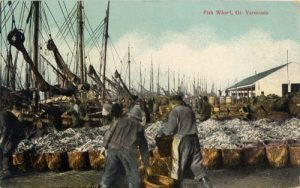
Herring crans being landed on the Fish Wharf, Great Yarmouth
In all of the fisheries of the British Isles local standards survived with only incidental changes until the spread of the railways created the commercial pressures that brought industry-wide standard measures. Even so, despite the rapid spread of the railways, change still came about quite slowly. The herring cran, a long-standing measure with many local variations was not standardised until 1908. The Cran Measure’s Act (1st August 1908), defined the cran as comprising 3,712 imperial gallons. This, and the quarter cran became the only legal measures for use in connection with the fresh herring trade in England and Wales; but herrings can also be sold by weight, number or in bulk. Lloyd’s Calendar, [London 1909]
Traditional local measures were customary and implied and as such rarely held any formal standing. There are few recorded dimensions of such measures nor, so far as we can tell, were they verified by inspection or by marking. However, some may well have been, and local ‘assizes’ in some fishing towns may have addressed this point.
Pilchards
In the pilchard fishery the standard measure was originally a volumetric one, which later acquired a weight value, and a numerical mean value of fish. This numerical mean was an accepted number, but with differing sizes of fish frequently being caught, the number actually contained varied significantly. Where a common measure applied to different varieties of fish any such variation was amplified. It appears that such variation was another causal factor in bringing about some of the many local variations, on an otherwise common measure, by introducing local ‘make weight’ factors – more of this below.
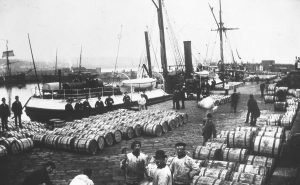
Hogsheads of Pilchards, on the dockside at Penzance, for loading in the s.s. Adria, probably November1885
[NMMC – Gibson (Fox accession).]
At a very early stage the hundred was used to tally pilchard catches, and the 126 fish hundred of pilchards, was simply one tally fish for every score – giving six score plus six tally fish (120 + 6 = 126].
Mathematically the three most basic constructions of long-hundred variants, would appear to be:
- 12 lots of 10 fish; being 120 + 12 (tally fish) making 132
- 6 lots of 20 fish; being 120 +6 (tally fish) making 126
- 3 lots of 40 fish; being 120 + 3 (tally fish) making 123
In tallying pilchard catches there were thirty hundreds to a hogshead, or three thousands each of ten hundreds. Seine caught pilchards usually resulted in bulk landings of dozens or hundreds of hogsheads, while the relatively small catches taken by individual driving boats were usually expressed in hundreds or thousands. Occasionally if the catch was very good, there might be a few hogsheads. But all too frequently a hail from the shore of, ‘What have ‘e got?’, as the pilchard drivers came into land, would evince the reply of, ‘Not a life!’ Even so, the catches made by the little pilchard drivers should not be underestimated, and aggregated catch of the fleet could produce several hundred hogsheads per night when the fishing was good.
The bigger bulk catches made by the seines carried a requirement for a larger bulk measure than the hundred, but one handier than the thousand. Over time an intermediate measureof three hundreds was introduced by the adoption of the maund. [Also ‘Maun’ or ‘Mawn’. Cornish phonetic variants. By comparison the Indian ‘maund’ also had many different values. The Bengal maund was just over 82lbs; that at Bombay just under 28lbs; and that at Madras just under 25lbs].
The maund was a stout, two-handled, wicker basket, intended to contain three hundreds of pilchards, and became a notional standard. At ten maunds to the hogshead this was both a convenient and handy measure, with a nominal content of about 50-55 lbs of fresh fish.
One of the distinctive uses of maunds was in tallying pilchards into and out of seine boats. With a short length of line attached to each handle, two men sitting astride the gunwale of a seine boat, would use them to dip the pilchards out of the ‘tuck net’ into the boat.
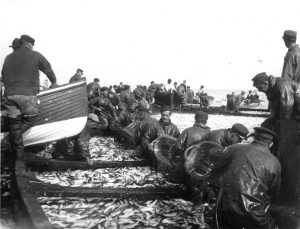
Tucking the seine off St Ives. Dippers hauling maunds full of pilchard from the tuck into the ‘lander’ [Studio St Ives 1960s]
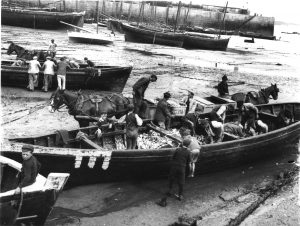
Landing Pilchards at St. Ives. Maunds full of pilchards being discharged into lidded box-carts – to prevent pilfering on their way to the fish-curing cellars.
[Studio St. Ives. (1960s)]
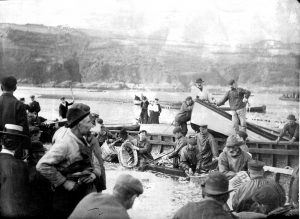
Tucking the Seine off St. Ives. Dippers hauling maunds full of pilchards from the tuck, into the lander.
[Studio St. Ives. (1960s)]
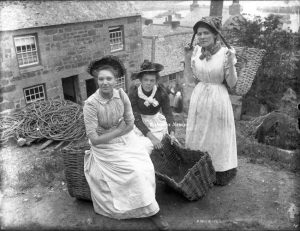
Young Newlyn fish-wives with their cowels pose for the cmaera at the top of Church Street in the 1890s [Pawlyn/Tregoning collection: (HCW photographer?)]
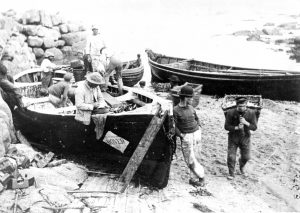
Landing pilchard by the ‘Cowel’ at Sennen Cove. Note the man sitting on the gunwale keeping tally, with an idler leaning against the bow.
[Tony Pawlyn collection: unattributed]
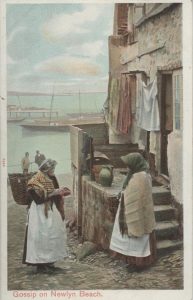 Although no longer used so frequently for discharging fish from the luggers after the 1870s, the cowel continued in use up until the 1920s. In this latter period they were used by pedestrian fish-hawkers, fish-wives, or ‘back-jousters’, as they were called to distinguish them from regular ‘jousters’ or fish-hawkers, who sold their fish from carts, who would buy fish fresh from the boats and then tramp the length and breadth of West Cornwall selling them in farmsteads and villages. These colourful characters feature in many turn of the century photographs.
Although no longer used so frequently for discharging fish from the luggers after the 1870s, the cowel continued in use up until the 1920s. In this latter period they were used by pedestrian fish-hawkers, fish-wives, or ‘back-jousters’, as they were called to distinguish them from regular ‘jousters’ or fish-hawkers, who sold their fish from carts, who would buy fish fresh from the boats and then tramp the length and breadth of West Cornwall selling them in farmsteads and villages. These colourful characters feature in many turn of the century photographs.
As indicated 300s of pilchards, at 50-55 lbs seems to have been accepted as a fair working load to carry. One man could not carry a maund very far because, with all the load out in front, it was out of balance. The gurry was another local contrivance introduced to overcome this problem. The gurry was a large rectangular box which would carry about six hundredsof pilchards. With squat legs at each corner, and two long carrying poles fixed to each side, they were carried, stretcher like, by two men. The gurry was used to carry fish from the boats to the curing cellars. Used principally, though not exclusively, at St. Ives they remained in regular use well into the photographic era.
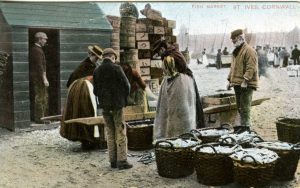
Fish market, St Ives. Gurries and maunds full of fish stand outside one of the buyers’ huts.
Herring and Mackerel
For the bigger fish, herring and mackerel, the terms and measures used seem to have grown out of the attempts to reflect the actual number of fresh fish sold more accurately, and these centred on the long-hundred. At Newlyn the hundred of herring seems to have been influenced by the East Coast fishermen and buyers that visited the port in increasing numbers from the 1850’s. These were attracted by the prospects of the mackerel fishery and in this they conformed with local practices. At Newlyn a hundred of mackerel was a straight 120 fish.
Occasionally mackerel were caught in very small numbers and the smallest counting unit was a warp. N.B. This was not the warp used in tallying the catch in Wales. Here a warp was just four fish – basically two fish taken in each hand as they were being counted. Similarly a warp of herring was also four fish. The hundred of mackerel consisted of 30 warps, while the hundred of herring consisted of 33 warps. One possible explanation of this difference is the ‘make-weight’ factor. ‘Make-weight’ factors seem to have arisen from moves by the fish buyers to have a set allowance for under-sized or broken fish without the need for actual checks. In some ports or fishing stations this factor seems to have led to fixed local modifications to the hundred.
In the case of herring there is an alternative make-weight theory as to why a hundred of 132 fish was adopted. Herring being normally slightly smaller than mackerel, the extra dozen fish might have been regarded to make two respective hundreds of about equal weight. Certainly 100 hundreds of mackerel or herrings were accepted as a last, which was considered to be about two tons of fish in either case. Of course the 100 hundreds of mackerel would have contained 12,000 fish, whereas the equivalent in herrings contained 13,200. In practice the relative difference in quantities is insufficient to produce a close enough equivalent weight for catches of these two species of fish, unless they were catching much bigger herring then.
Another make-weight factor seems to have given rise to the cast. In its simplest form it was just that – a cast aside of a handful of fish to make weight. In pilchards a cast was one handful, or five fish; but with mackerel it had become more than this. At Newlyn, by the 1860s a cast of mackerel was three warps – 12 fish. At some distant time it would appear that the terms cast and warp were synonymous, and just why and when this change occurred is unrecorded. From the 1860s until the 1950s, mackerel were sold at Newlyn by auction, at first on the foreshore, but later at the new mackerel market.
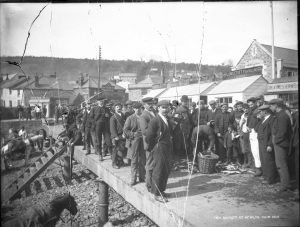
The new Mackerel Market, Newlyn, c.1905. Note the sample of fish in the deck, and the Fish-buyers’ huts behind the crowd.
[Pawlyn/Tregoning collection (H.C.W. photographer?) – from a smashed glass-plate negative.]
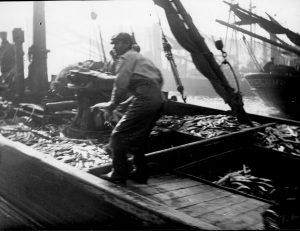
Mate of the Lowestoft steam drifter picking out his sample of mackerel to display on the market, c.1910. [Pawlyn/Holman collection: Percy Holman.]
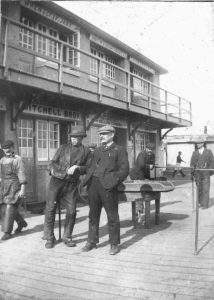
A Fish buyer and a ‘Yorkie’ mate on Newlyn Mackerel market in the 1930s. [Tony Pawlyn collection: family photo.]
The numerical value of a cast of mackerel does not seem to have been the same at all fishing stations. At Kinsale mackerel fishery, in April 1873, there was a fishermen’s strike against the concerted attempt of the buyers to gain an additional 6d. in the £ discount. This was resisted most strongly, the fishermen pointing out that they already gave the buyers ‘two casts of fish in each 120’. The fishermen ‘approached’ each buyer individually and persuaded a number of them to acknowledge the established system of six score and two casts. After three days of unrest and disturbances sufficient buyers agreed to the established terms, bringing an end to the dispute – but not before one fisherman, James Gorry, had been shot dead by the police. [Cornish Telegraph – 16/04/1873]
Unfortunately there is no indication of how many fish these two casts represented. It seems probable that each cast here was of four fish. If they had amounted to 24 fish, as at Newlyn, then this would have been the equivalent of a 20% allowance, which seems much too high. Far more likely was that these were two casts of four, making eight fish, equivalent to a 6.6% allowance – an allowance ‘in kind’ very close to the financial discount allowed to the buyers at Newlyn for prompt payment.
Mackerel continued to be sold by the hundred until this traditional measure was replaced by the ubiquitous stone in the early 20th Century. But, as mackerel weighed in the order of one to two pounds each, 120 mackerel was not a handy quantity. Baskets nominally carrying half-a hundred mackerel, known as pads were used. The pad has descended from an Elizabethan wicker basket called a ‘ped’. In the 1830s the pad was in use at Folkestone for trawl fish, in conjunction with an undefined measure, the pot. Three pots to a pad, but two pots to a half-pad! [E. J. March. Sailing Trawlers, 2nd edition. Newton Abbot 1970, p. 37]
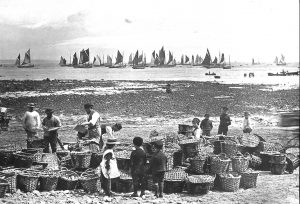
Mackerel pads on one of the buyers’ stands on the beach at Newlyn, in the early 1880s.
[Tony Pawlyn collection: unattributed.]
A pad of mackerel at Newlyn seems to have held a similar weight. Here there were five casts to a pad, and two pads to a hundred. The pad was a fully accepted measure and the most common way of counting mackerel landings and consignments. These pads had a wicker flap lid that could be fastened down, sealing in the contents. This enabled them to be stacked two or three high without damaging the contents making them very convenient for transporting the mackerel.
As with other containers, the numbers of fish actually contained varied considerably with the size of the fish. In reports from the 1867 mackerel season, on Saturday 15th June, some particularly fine mackerel of up to 2 lb 10 oz per fish were landed with ’40 filling a pad.’ [Cornish Telegraph, 103/07/1867]
While a few years later, during April 1871 there were some mixed catches with some so small that it took 100 mackerel to fill a pad. [Cornish Telegraph, [19/04/1871)
Although pads were made by the basket-makers ‘by eye,’ in their thousands, one with another, these would have carried about the same weight per species.
Weight per Measure
In Table 2 I have tried to indicate comparative measures as they applied to the three main types of pelagic fish landed at Newlyn. Against these measures I have also indicated the nominal number of fish contained, and have tried to indicate a true ‘norm’ weight of fish per measure. These comparisons appear acceptable for pilchards, with the only query arising from the Fishery Inspector’s Report, that a hundred pilchards weighed 30 lbs, whereas all other measures support a norm of 15 lbs. I am much less satisfied with the veracity of these results when applied to herring and mackerel. The First Annual Report of the Inspector of Sea Fisheries for 1886, [British Parliamentary Papers, 1887. XXI, 129 et seq. ], set out a number of measures by which fish were brought to market, with corresponding weights in some cases. Not all of these agree with other contemporary data, and it is difficult to determine which was correct.
Particularly frustrating is the weight per measure of herring and mackerel. In the above report a hundred of herring is given as 45 lbs, – less than half the norm by my own calculations.
[A quick check in the market last week (8/8/1994) found pilchards of about 2oz each; herrings of 12 oz; and medium mackerel of 16oz. Applying this ratio 2:12:16 against respective hundreds of 120:132:120 for each type of fish would give us a mean of 15.99 ozs per fish, and 120 lbs of fish per respective hundred.]
By the same token one would expect a hundred of mackerel (for which no weight is quoted] to be about the same as for herring. Whereas, allowing for the different number of fish in each respective hundred, these would appear to have been closer to about a hundred-weight [112lb.]. Now a weight of 45 lbs per hundred equates very well to the last of two tons, and it may be that the Fishery Inspectorate (or his informants] calculated back from the last by division. By such a token one would expect a pad of 60 mackerel to weigh 22 ½ lbs, but this is much too light to be acceptable.
Whatever the number of fish in a pad one would expect the weight of full pads to be fairly constant. If one takes the case of the pads of mackerel in 1867, which were filled by only 40-45 fish of between 2 lb and 2 lb 10 oz. Then these pads of mackerel would have weighed between 80 lbs, and 118 lbs, – say 100 lbs. This is a much more likely amount and such a pad equates reasonably to a Barking pad of 98 to 112 lbs Weights of this order tie in with Yarrell’s observations [1836] that mackerel were normally of 2 lbs each. [William Yarrell. A History of British Fish. Vol 1. (London, 1836), page 124]
However at this weight, grave problems occur in relating pads to lasts: Given 200 pads per last (ten thousands or a hundred hundreds), this would produce a last of twenty thousand pounds, or nearly nine tons. Clearly a gross mis-match. Even allowing my best estimates of the true mean norm, with herring of three-quarters of a pound, and mackerel of only a pound, we have lasts of herrings in the order of four and a half tons, and lasts of mackerel over five tons. There is clearly something wrong here, but just quite what I have been unable to fathom out. The last was quite universally accepted to be about two tons. So who was diddling whom? It looks to me as though the poor fishermen lost out again. If the merchants paid them for two tons of fish, and then sold double that amount or more, then by this measure they could have sold at a ‘loss’ and still made a profit. I leave this conundrum with you and would be interested in any plausible explanations.
As indicated above, many of the older units were approximate measures, and by custom and usage, came to include additional amounts as ‘make-weight’. In modern times most of these have been swept away by various Weights & Measures Acts. From the commencement of the British Fishery Statistics, in the early 1870s, the hundredweight [cwt] became the official yardstick for assessing the state of the fisheries, though there is no explanation as to how they converted fish catches to the hundredweight. About the same time most fish markets adopted the Stone [14 lbs] as the standard unit of sale by weight, though sales by traditional measures continued for many more years. Modern containers vary in size, but are usually multiples of ‘a stone’. This is reasonably effective as fish have near enough the same mass and density, so that, despite all the problems with converting traditional measures, a given volume roughly equates to a given weight of fish. More recently we have moved on to Kilos and the like, but that is another topic.
